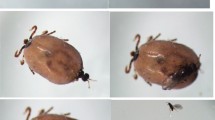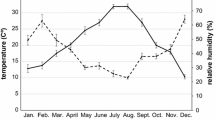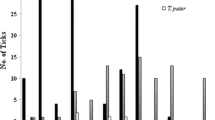Abstract
The parasitism of Ixodes loricatus Neumann on white-eared opposum, Didelphis albiventris Lund, was analysed in the southern ranges of both. In central Argentina, 118 wild opossums were captured from 2005 to 2012. Adults of I. loricatus were collected (prevalence = 66.1%, mean = 7.03, median = 4), but no immature stage. Tick infestation was not affected by sex (p = 0.27) or age (p = 0.37) of hosts. In line with previous studies about seasonality of larvae and nymphs of I. loricatus, adult tick infestation showed no seasonal trend. This lack of seasonal pattern of infestation for all parasitic stages of I. loricatus may indicate a life cycle governed by nidicolous behaviour, in such a way that this habit would contribute to minimize the influence of external environmental variables. The tick sex ratio was female biased, with two females per one male (p = 0.002). The absence of I. loricatus immatures on D. albiventris suggests that in the study region there is clear segregation of immatures in rodents and adults in marsupials.

Similar content being viewed by others
References
Beldomenico PM, Lareschi M, Nava S, Mangold AJ, Guglielmone AA (2005) The parasitism of immature stages of Ixodes loricatus (Acari: Ixodidae) on wild rodents in Argentina. Exp App Acarol 36:139–148
Burkart R, Bárbaro O, Sánchez RO, Gómez DA (1999) Eco-Regiones de la Argentina. Administración de Parques Nacionales, Secretaría de Recursos Naturales y Desarrollo Sustentables, Buenos Aires, p 43
Cerqueira R (1985) The distribution of Didelphis in South America (Polyprotodontia, Didelphidae). J Biogeogr 12:135–145
Coelho MG, do Nascimento Ramos V, Limongi JE, de Lemos ERS, Guterres A, da Costa Neto SF, Rozental T, Rodrigues Bonvicino C, D’Andrea PS, Moraes-Filho J, Labruna MB, Szabó MPJ (2016) Serologic evidence of the exposure of small mammals to spotted-fever Rickettsia and Rickettsia bellii in Minas Gerais, Brazil. J Infect Dev Ctries 10:275–282
Colombo VC, Guglielmone AA, Monje LD, Nava S, Beldomenico PM (2014) Seasonality of immature stages of Ixodes loricatus (Acari: Ixodidae) in the Paraná Delta, Argentina. Ticks Tick Borne Dis 5:701–705
Colombo VC, Nava S, Antoniazzi LR, Monje LD, Racca AL, Guglielmone AA, Beldomenico PM (2015) Ecology of the interaction between Ixodes loricatus (Acari: Ixodidae) and Akodon azarae (Rodentia: Criceridae). Parasitol Res 114:3683–3691
Flores DA (2006) Orden Didelphimorphia Gill, 1872. In: Barquez RB, Díaz MM, Ojeda RA (eds) Mamíferos de Argentina. Sistemática y distribución, Sociedad Argentina para el estudio de los mamíferos
Flores DA, Díaz MM, Barquez RB (2006) Systematic and distribution of marsupials in Argentina: a review. In: Kelt DA, Lessa EP, Salazar- Bravo J, Patto JL (eds) The quintessential naturalis. Honoring the life and legacy of Oliver P. Pear, vol 134. University of California Publications. Zoology, California, pp 1–981
Gómez L, Santa Cruz AM, Borda JT, Lombardero OJ (2000) Nueva localización en Argentina de Ixodes loricatus Neumann, 1899 (Acari: Ixodidae) parasitando a Didelphis albiventris. Rev Med Vet Nordeste 81:340–341
Guglielmone AA, Nava S, Díaz MM (2011) Relationships of South American marsupials (Didelphimorphia, Microbiotheria and Paucituberculata) and hard tick (Acari:Ixodidae) with distribution of four species of Ixodes. Zootaxa 3086:1–30
Guglielmone AA, Robbins RG, Apanaskevich DA, Petney TN, Estrada-Peña A, Horak I (2014) The hard ticks of the world. Springer, Dordrecht, pp 978–994
Hoogstraal H, Aeschlimann A (1982) Ticks- host specificity. Bulletin de la Societé Entomolgique Suisse 55:5–32
Horta MC, Pinter A, Schumaker TS, Labruna MB (2006) Natural infection, transovarial transmission, and transstadial survival of Rickettsia belli in the tick Ixodes loricatus (Acari: Ixodidae) from Brazil. Ann NY Acad Sci 1078:285–290
Kiszewski AE, Matuschka ER, Spielman A (2001) Mating strategies and spermiogenesis in Ixodid ticks. Ann Rev Entomol 46:167–182
Lareschi M (2010) Ectoparasite occurrence associated with males andfemales of wild rodents Oligoryzomys flavescens (Waterhouse) and Akodon azarae (Fischer) (Rodentia: Cricetidae: Sigmodontinae) in the Punta Lara Wetlands, Argentina. Neotrop Entomol 39:818–822
McCoy KD, Tirard C (2002) Reproductive strategies of the seabird tick Ixodes uriae (Acari: Ixodidae). J Parasitol 88:813–816
Musser GG, Carleton MD (2005) Superfamily muroidea. In: Wilson DE, Reeder DA (eds) Mammal species of the world: a geographic and taxonomic reference. The John Hopkins University Press, Baltimore, pp 894–1531
Nava S, Mangold AJ, Guglielmone AA (2009) Seasonal distribution of larvae and nymphs of Amblyomma tigrinum Koch, 1844 (Acari: Ixodidae). Vet Parasitol 166:340–342
Nava S, Venzal JM, González-Acuña D, Martins TF, Guglielmone AA (2017) Ticks of the Southern Cone of America: diagnosis, distribution and hosts with taxonomy, ecology and sanitary importance. Elsevier Academic Press, London, p 352
Onofre-Barragán B (2015) Estudio preliminar de artrópodos de importancia veterinaria en El Carmen, Municipio de Xochistlahuaca, Guerrero, México. Boletín de la Sociedad Mexicana de Entomología (Nueva Serie) 1:118–121
Randolph SE (1980) Population regulation in ticks: the effects of delayed mating on fertility in Ixodes trianguliceps (Acarina: Ixodidae). J Parasitol 66:287–292
Saraiva DG, Fournier GF, Martins TF, Leal KPG, Vieira NF, Camara EMVC, Costa CG, Onofrio VC, Barros-Battesti DM, Guglielmone AA, Labruna MB (2012) Ticks (Acari: Ixodidae) associated with small terrestrial mammals in the state of Minas Gerais, southeastern Brazil. Exp Appl Acarol 58:159–166
Schumaker TTS, Labruna MB, Abel IDS, Clerici PTS (2000) Life cycle of Ixodes (Ixodes) loricatus (Acari: Ixodidae) under laboratory conditions. J Med Entomol 37:714–720
Schweigmann NJ, Pietrokovsky S, Bottazzi V, Conti O, Bujas MA, Wisnivesky-Colli C (1995) Estudio de la prevalencia de la infección por Trypanosoma cruzi en zarigüeyas (Didelphis albiventris) en Santiago del Estero, Argentina. Rev Panam Salud Publica 6:371–377
Serra-Freire NM, Sena LMM, Borsoi ABP (2011) Parasitismo humano por carrapatos na Mata Atlántica, Rio de Janeiro, Brasil. Entomol Brasilis 4:67–72
Tarragona EL, Zurvera D, Manzoli DE, Correa AI, Delgado AR, Magni C, Beldomenico PM (2014) Inmovilización química y evaluación fisiológica de comadreja overa, Didelphis albiventris (Lund, 1841) silvestres de la provincia de Santa Fe, Argentina. InVet 16:79–85
Acknowledgements
The authors thank Armando Rubén Delgado (Catedra de Bacteriología Universidad Nacional del Litoral-UNL), Darío Exequiel Manzoli, Ana Inés Correa, Leandro Raúl Antoniazzi, Maria Ayelen Teresita Eberhardt (ICIVET—Litoral, Universidad Nacional del Litoral-UNL) and “Grupo CAPIBARA” of the Facultad de Ciencias Veterinarias de la Universidad Nacional del Litoral, for help during field work.
Author information
Authors and Affiliations
Corresponding author
Rights and permissions
About this article
Cite this article
Tarragona, E.L., Mastropaolo, M., Zurvera, D. et al. Host-parasite association between Didelphis albiventris (Didelphimorphia: Didelphidae) and Ixodes loricatus (Acari: Ixodidae) in their southern ranges. Exp Appl Acarol 75, 129–134 (2018). https://doi.org/10.1007/s10493-018-0248-9
Received:
Accepted:
Published:
Issue Date:
DOI: https://doi.org/10.1007/s10493-018-0248-9




